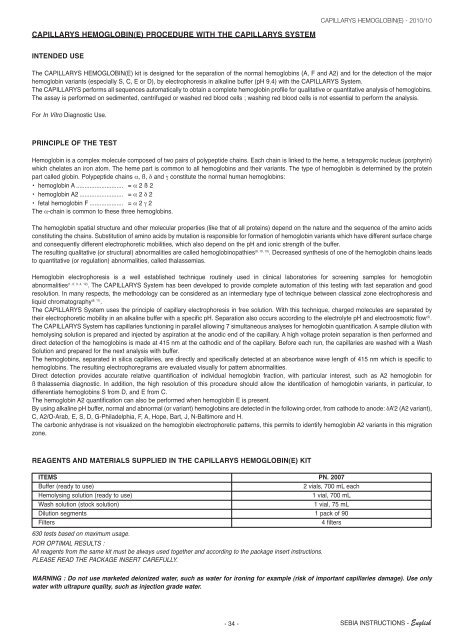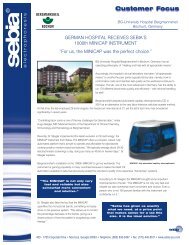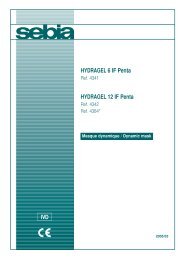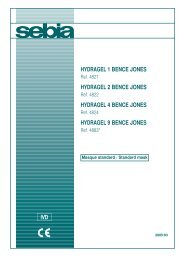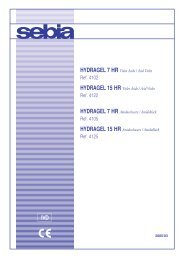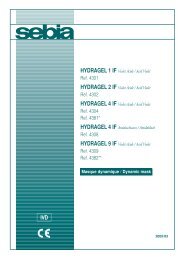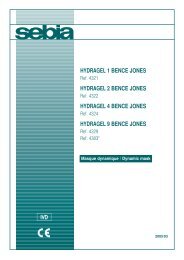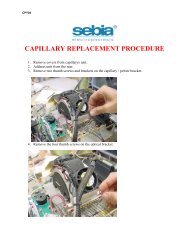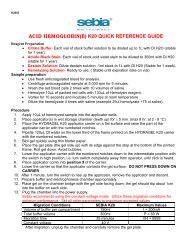CAPILLARYS HEMOGLOBIN(E)
CAPILLARYS HEMOGLOBIN(E) - Sebia Electrophoresis
CAPILLARYS HEMOGLOBIN(E) - Sebia Electrophoresis
- No tags were found...
Create successful ePaper yourself
Turn your PDF publications into a flip-book with our unique Google optimized e-Paper software.
<strong>CAPILLARYS</strong> <strong>HEMOGLOBIN</strong>(E) - 2010/10<br />
<strong>CAPILLARYS</strong> <strong>HEMOGLOBIN</strong>(E) PROCEDURE WITH THE <strong>CAPILLARYS</strong> SYSTEM<br />
INTENDED USE<br />
The <strong>CAPILLARYS</strong> <strong>HEMOGLOBIN</strong>(E) kit is designed for the separation of the normal hemoglobins (A, F and A2) and for the detection of the major<br />
hemoglobin variants (especially S, C, E or D), by electrophoresis in alkaline buffer (pH 9.4) with the <strong>CAPILLARYS</strong> System.<br />
The <strong>CAPILLARYS</strong> performs all sequences automatically to obtain a complete hemoglobin profile for qualitative or quantitative analysis of hemoglobins.<br />
The assay is performed on sedimented, centrifuged or washed red blood cells ; washing red blood cells is not essential to perform the analysis.<br />
For In Vitro Diagnostic Use.<br />
PRINCIPLE OF THE TEST<br />
Hemoglobin is a complex molecule composed of two pairs of polypeptide chains. Each chain is linked to the heme, a tetrapyrrolic nucleus (porphyrin)<br />
which chelates an iron atom. The heme part is common to all hemoglobins and their variants. The type of hemoglobin is determined by the protein<br />
part called globin. Polypeptide chains α, ß, δ and γ constitute the normal human hemoglobins:<br />
• hemoglobin A ............................ = α 2 ß 2<br />
• hemoglobin A2 .......................... = α 2 δ 2<br />
• fetal hemoglobin F .................... = α 2 γ 2<br />
The α-chain is common to these three hemoglobins.<br />
The hemoglobin spatial structure and other molecular properties (like that of all proteins) depend on the nature and the sequence of the amino acids<br />
constituting the chains. Substitution of amino acids by mutation is responsible for formation of hemoglobin variants which have different surface charge<br />
and consequently different electrophoretic mobilities, which also depend on the pH and ionic strength of the buffer.<br />
The resulting qualitative (or structural) abnormalities are called hemoglobinopathies (9, 10, 13) . Decreased synthesis of one of the hemoglobin chains leads<br />
to quantitative (or regulation) abnormalities, called thalassemias.<br />
Hemoglobin electrophoresis is a well established technique routinely used in clinical laboratories for screening samples for hemoglobin<br />
abnormalities (1, 2, 3, 4, 12) . The <strong>CAPILLARYS</strong> System has been developed to provide complete automation of this testing with fast separation and good<br />
resolution. In many respects, the methodology can be considered as an intermediary type of technique between classical zone electrophoresis and<br />
liquid chromatography (8, 11) .<br />
The <strong>CAPILLARYS</strong> System uses the principle of capillary electrophoresis in free solution. With this technique, charged molecules are separated by<br />
their electrophoretic mobility in an alkaline buffer with a specific pH. Separation also occurs according to the electrolyte pH and electroosmotic flow (5) .<br />
The <strong>CAPILLARYS</strong> System has capillaries functioning in parallel allowing 7 simultaneous analyses for hemoglobin quantification. A sample dilution with<br />
hemolysing solution is prepared and injected by aspiration at the anodic end of the capillary. A high voltage protein separation is then performed and<br />
direct detection of the hemoglobins is made at 415 nm at the cathodic end of the capillary. Before each run, the capillaries are washed with a Wash<br />
Solution and prepared for the next analysis with buffer.<br />
The hemoglobins, separated in silica capillaries, are directly and specifically detected at an absorbance wave length of 415 nm which is specific to<br />
hemoglobins. The resulting electrophoregrams are evaluated visually for pattern abnormalities.<br />
Direct detection provides accurate relative quantification of individual hemoglobin fraction, with particular interest, such as A2 hemoglobin for<br />
ß thalassemia diagnostic. In addition, the high resolution of this procedure should allow the identification of hemoglobin variants, in particular, to<br />
differentiate hemoglobins S from D, and E from C.<br />
The hemoglobin A2 quantification can also be performed when hemoglobin E is present.<br />
By using alkaline pH buffer, normal and abnormal (or variant) hemoglobins are detected in the following order, from cathode to anode: δA’2 (A2 variant),<br />
C, A2/O-Arab, E, S, D, G-Philadelphia, F, A, Hope, Bart, J, N-Baltimore and H.<br />
The carbonic anhydrase is not visualized on the hemoglobin electrophoretic patterns, this permits to identify hemoglobin A2 variants in this migration<br />
zone.<br />
REAGENTS AND MATERIALS SUPPLIED IN THE <strong>CAPILLARYS</strong> <strong>HEMOGLOBIN</strong>(E) KIT<br />
ITEMS PN. 2007<br />
Buffer (ready to use)<br />
2 vials, 700 mL each<br />
Hemolysing solution (ready to use)<br />
1 vial, 700 mL<br />
Wash solution (stock solution)<br />
1 vial, 75 mL<br />
Dilution segments 1 pack of 90<br />
Filters<br />
4 filters<br />
630 tests based on maximum usage.<br />
FOR OPTIMAL RESULTS :<br />
All reagents from the same kit must be always used together and according to the package insert instructions.<br />
PLEASE READ THE PACKAGE INSERT CAREFULLY.<br />
WARNING : Do not use marketed deionized water, such as water for ironing for example (risk of important capillaries damage). Use only<br />
water with ultrapure quality, such as injection grade water.<br />
- 34 -<br />
SEBIA INSTRUCTIONS - English


